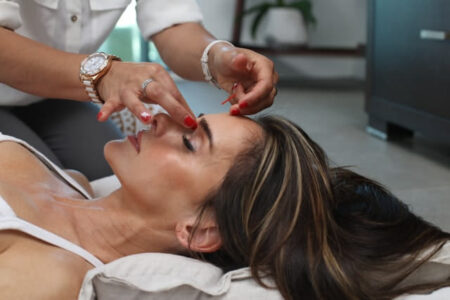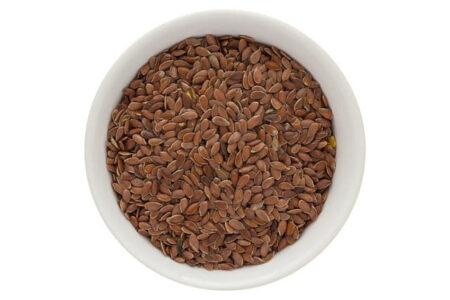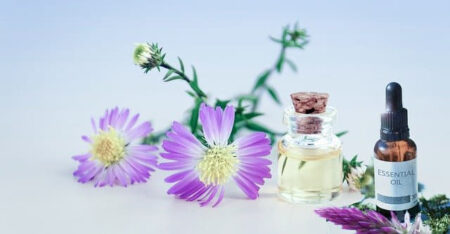Hot flashes, palpitations, irritability and weight gain.
These are just some of the symptoms of menopause.
Why does this happen in women and what natural treatments can ease menopause symptoms?
Causes and symptoms of menopause
Female menopause usually occurs between the ages of 45 and 55, after twelve months without menstruation.
After a drop in estrogen levels, menstrual cycles begin to disappear.
At the same time, various negative effects begin.
These symptoms include one or more of the following:
Mood swings, hot flashes, vaginal dryness, decreased libido, vaginal and urinary tract infections, insomnia and more.
The most common and well-known phenomenon are hot flashes.
Its frequency varies from woman to woman.
The phenomenon is characterized by waves of extreme heat and sweating, followed by a feeling of cold.
These hot flashes mainly appear at night.
Natural treatment for menopause symptoms
Contact therapy for menopausal symptoms

Reflexology, acupuncture and the Korean acupuncture Su Juk can greatly support and strengthen the menopause.
It is desirable and worthwhile to combine them in treatment.
Sports for mood improvement
During menopause, it is important to maintain an aerobic exercise routine.
The recommended dose is an activity equivalent to 30 minutes of brisk walking daily.
Studies show that exercise increases levels of chemicals responsible for mental state, such as serotonin.
Therefore, exercise is effective in improving mood.
Drinking excessive water to reduce hot flashes
This may sound too easy, but simply by drinking plenty of cold water throughout the day you can reduce hot flashes by up to 25%.
One of the reasons why it is important to drink more water in general during menopause is that the feeling of thirst is often replaced by a false feeling of hunger.
As a result, we eat more and drink less, causing us to gain weight and have more difficulty managing our daily lives.
Sharing is caring

You should be aware that this is a process that every woman experiences.
Because different women experience it in different ways.
You need to share what you are going through with friends and family,
so they can better understand what is causing the mood swings you are feeling.
Recommended diet for treating menopausal symptoms
Vitamin E to treat hot flashes
Many studies have shown that the antioxidants in vitamin E compounds are especially effective in treating hot flashes.
These antioxidants are also effective in treating night sweats that prevent us from sleeping well.
Foods rich in vitamin E include whole grains such as rye and whole rice.
You should also add fruits like watermelon and strawberry, nuts and legumes to your diet.
Soy and its products
It is highly advisable to include soy products in your diet to reduce hot flashes during menopause.
Soybeans contain a plant substance called phytoestrogens.
These phytoestrogens help the body achieve hormonal balance and, as a result, reduce hot flashes.
Several gynecologists recommend soy-containing supplements, while you can actually just eat soy products.
Soy products you can add to your diet include sugar-free soy milk, tofu, Tampa and miso.
You can also buy frozen soybeans in the pod and heat them in a pan of water.
Flaxseed as phytoestrogen

Flaxseed contains phytoestrogens called lignans.
These substances help with hormonal balance during menopause.
You should consume 1-2 tablespoons of ground flaxseed per day.
Grind the seeds just before eating to prevent oxidation of omega 3 and other delicate ingredients.
You can add the flaxseed to smoothies, salads or simply sprinkle it over food.
Foods containing phytoestrogens and calcium strengthen and support menopause:
Consume more foods containing phytoestrogens and calcium as these strengthen and support menopause.
Such foods include soy products, flax seeds, whole grains, oats, nuts, almonds, various seaweeds, vegetables, green leaves and more.
Remove warming and stimulating foods from your diet.
Such foods include red meat and foods containing empty carbohydrates, caffeine and alcohol.
Vitamin C
Vitamin C and bioflavonoid compounds (formerly known as vitamin P) are essential substances for the body.
These substances can naturally treat allergies and inflammation.
Although hot flashes are a natural phenomenon and not caused by an infection,
It was discovered that eating foods rich in vitamin C and bioflavonoid compounds can greatly relieve people who suffer from hot flashes.
Foods rich in these substances are citrus fruits, red wine and also tomatoes.
Herbal medicine for the treatment of menopausal symptoms

Black cohosh
The use of the cohosh plant is very common in Europe and is mainly used to treat symptoms of menopause and hot flashes.
The active ingredient in the plant acts as a natural substitute for the female estrogen hormone,
which balances the hormonal state in the body.
Keep in mind that the effects of cohosh take time to kick in and relief from hot flashes should not be expected immediately.
In addition, hormone replacement is not suitable for anyone and therefore a doctor should be consulted before starting this treatment.
Stellaria Media
The common Stellaria plant is considered a risk-free remedy for various medical conditions in traditional medicine.
Such conditions include joint pain, pneumonia, asthma, infected wounds and also symptoms of menopause.
This herb can be eaten whole, or you can look for extracts and dried leaves at your local health food stores.
A daily dose of a regular Stellaria can alleviate the severity of hot flashes and sometimes even eliminate them completely.
Sensible

Menopausal women who drank at least one cup of natural sage tea per day
were found to suffer much less from hot flashes than women who did not drink it.
Sage has a very wide range of health benefits,
and unlike other solutions from the plant world, it does not contain hormone replacement.
Dioscorea Villosa for the treatment of menopausal symptoms
The Dioscorea Villosa is a North American plant, also called wild yam.
Wild yam supports ovarian function and is suitable for the treatment of menopausal complaints.
It can treat hot flashes and night sweats, in addition to its antispasmodic and anti-inflammatory properties.
It synergizes with black cohosh, stabilizing and supporting hormonal balance while relieving menopausal symptoms.
Glycyrrhiza Glabra
Glycyrrhiza Glabra, also called licorice, is a plant that grows wild in Western Asia and Southern Europe.
It has been used medically for centuries around the world to treat a wide range of common health conditions.
It is used to treat conditions related to the digestive, respiratory and immune systems.
And also for the general strengthening of the body.
The root is also effective in supporting and stabilizing processes in the ovaries.
It is effective in the early stages of menopause, when the condition rapidly worsens and is accompanied by hot flashes and a difficult mental state.
Licorice root has a moisturizing effect, contains gel-like protective substances and is also effective for dry skin and vagina.
Verbena Officinalis
Verbena Officinalis is one of the most complete and useful herbs in herbal medicine, due to its broad effect on most systems of the body.
It is native to Europe and is known worldwide for its medicinal uses, mainly due to its effect on the nervous system.
Verbena generally aids in sedation and gentle regulation of physiological and metabolic processes in the body.
It is an important plant for treating the mental aspects of menopause.
Such aspects are conditions of overload and long-term mental stress.
These conditions are accompanied by headaches, migraines, sleep problems, anxiety, depression and general stiffness of the body.


